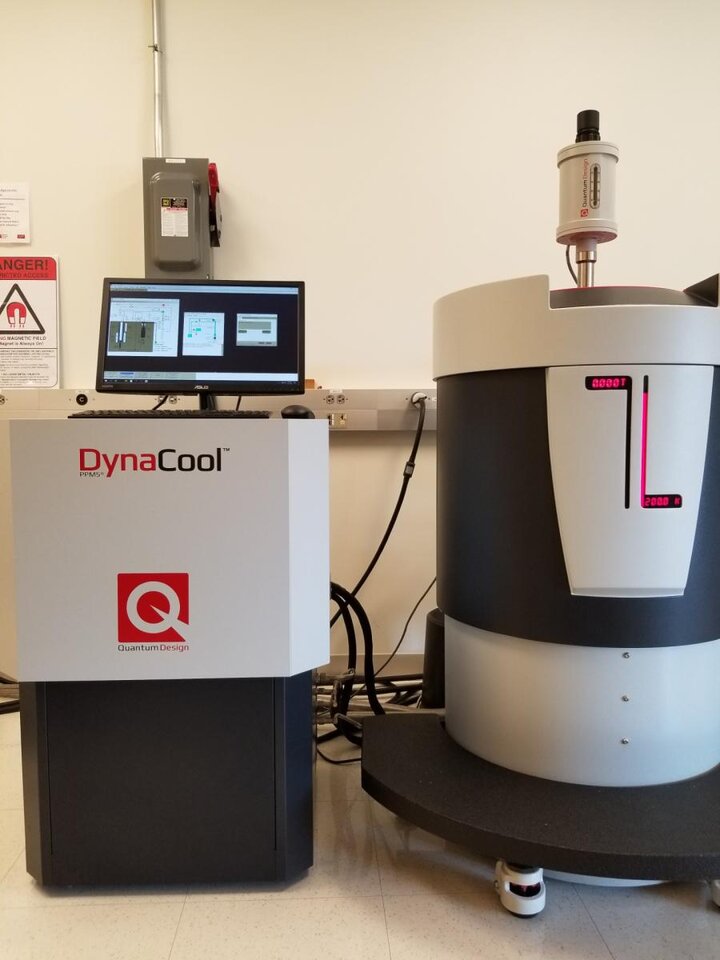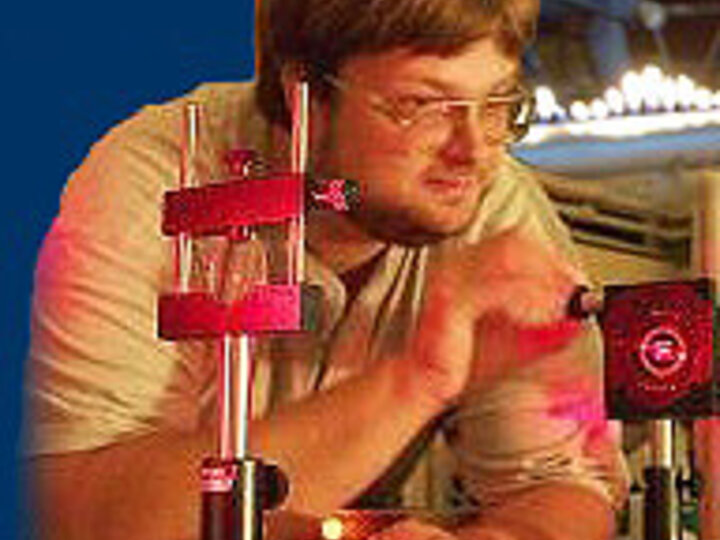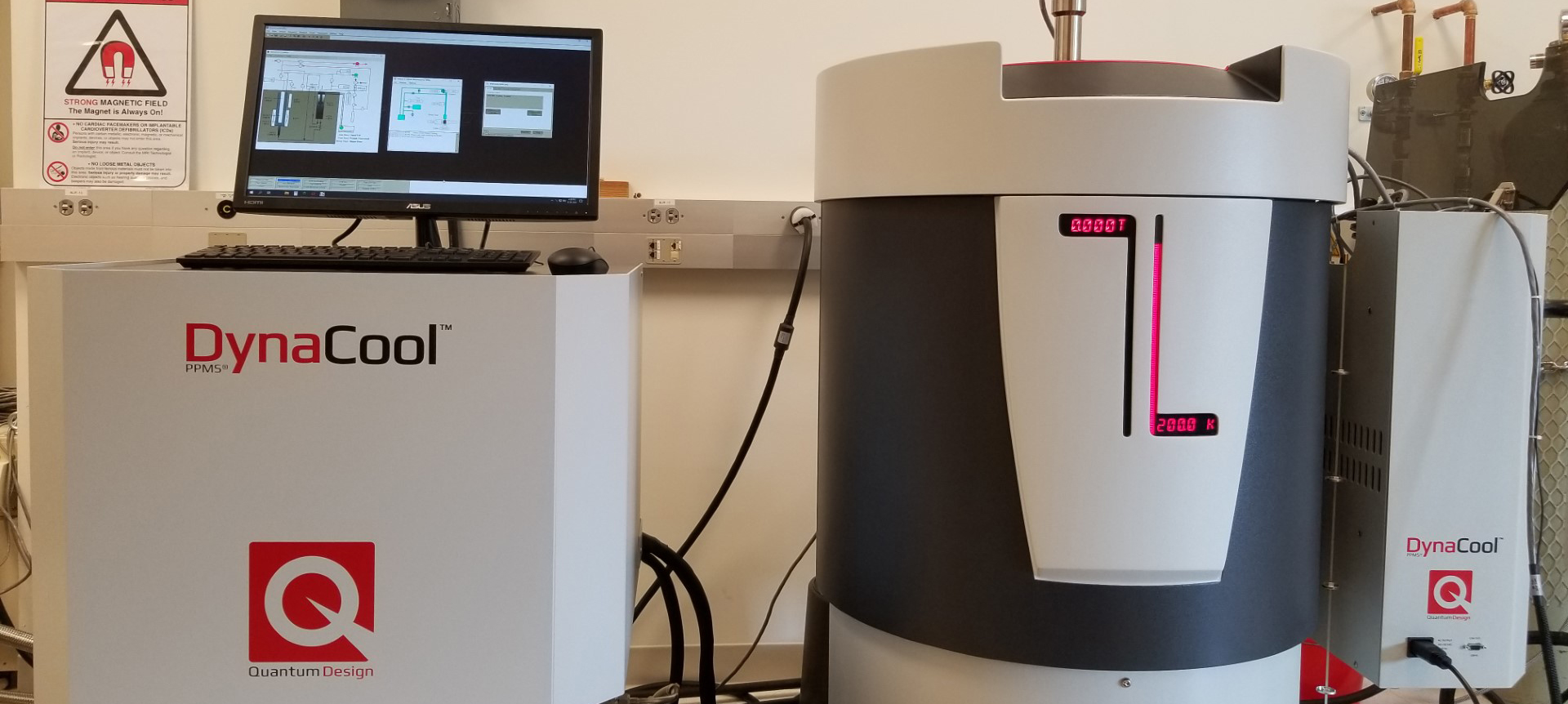About the Facility
The Physical Properties Facility focuses on equipment to measure and manipulate the magnetic moment. The facility boasts a DynaCool PPMS, the latest generation Physical Property Measurement System from Quantum Design. Other equipment includes an MPMS squid magnetometer, which offers advanced performance in all areas of magnetometry, and a 4.5 T magnetic annealing system for sample modification. The system combines high temperature annealing with a high magnetic field to potentially modify the magnetic properties of thin films and alloys. It uses high-temperature exchange interactions to form new magnetic properties and/or control the crystal growth. Also, the facility provides easy access to liquid nitrogen to various research groups in NCMN, MRSEC, and other groups at UNL such as the athletic department.
Cryogenics are vital and used by research groups for many purposes. Several superconducting magnets require a significant amount of liquid helium and liquid nitrogen, and many high vacuum systems and detectors use liquid nitrogen. Also, cryogenics are used in various experiments to measure materials properties at low temperatures. All undergraduates and graduate students involved in low temperature measurement and vacuum systems use the facility. This facility enables our research on magnetism and magnetic materials, nanoelectronics, solid-state chemistry, etc. It is thus an integral part of NCMN’s research portfolio.
Sign-Up Calendar
Check Status - MPMS SQUID
Acknowledgment Text
The research was performed in part in the Nebraska Nanoscale Facility: National Nanotechnology Coordinated Infrastructure and the Nebraska Center for Materials and Nanoscience (and/or NERCF), which are supported by the National Science Foundation under Award ECCS: 2025298, and the Nebraska Research Initiative.
X-ray Photoelectron Spectrometer (XPS)
X-ray photoelectron spectroscopy (XPS) is a surface analytical technique, which is based upon the photoelectric effect and measures the elemental composition, empirical formula, and chemical state of the elements within a material. XPS spectra are obtained by irradiating a solid surface with a beam of X-rays (Al Ka with an energy of 1486.6 eV) while simultaneously measuring the kinetic energy of photoelectrons that are emitted from the top 1-10 nm of the material being analyzed. Since the core-level XPS peaks for different elements appear at particular characteristic energies, the energies and intensities of the XPS peaks enable the identification and quantification of all elements from the surface (except hydrogen). Similarly, the chemical shifts and appearance of other special features, for example satellite and plasmon-loss peaks, in the XPS spectra are useful for chemical state analysis.

XPS has various scanning options: (i) Point scan: the spot size of the x-rays can be varied from 30 to 400 mm in 5 mm steps; (ii) Line and area scans are also possible with a maximum spatial resolution of 30 mm or better; (iii) K-alpha+ XPS is also capable of mapping the surface with a maximum spatial resolution of 30 mm or better and this is useful in understanding the elemental distribution across a surface.
A few other key features of the K-alpha+ XPS are also given below:
- Charge Compensation: If the surface of a material is electrically insulating, then the emission of photoelectrons causes a positive charge to accumulate at the surface. This causes the XPS peaks to shift to high binding energies. The charge on the surface can be neutralized by replenishing electrons from an Ar-ion flood source during the measurement.
- Depth Profiling: XPS also has an Ar ion beam for depth-profiling measurements (beam energy: 0.1 to 4 keV, current < 4 mA). This is helpful in etching away the surface contamination and also to investigate subsurface information. Combining a sequence of ion-gun etch cycles with XPS analyses provides quantified information as a function of layer thickness.
- Angle-resolved XPS (ARXPS): We also have a sample holder that can be tilted for performing ARXPS. ARXPS enables electron detection from different depths by varying the emission angle at which the electrons are collected. Such measurements are non-destructive and can be applied to films that are too thin to be analyzed by conventional depth-profiling techniques or films that are irretrievably damaged by sputtering (e.g., polymers).
Ultraviolet Photoelectron Spectroscopy (UPS) operates on the same principle as XPS, but ultraviolet (UV) radiation is used to induce the photoelectric effect. UV photons are produced using a gas discharge lamp, typically filled with helium and have energies of 21.2eV (He I) and 40.8eV (He II). As lower energy photons are used, spectral acquisition is limited to the valence-band region. UPS can precisely measure the Fermi edge, density of states in the valence band, and electronic work function of a material being investigated.
The Thermo Scientific K-alpha+ XPS/UPS system is user friendly and Avantage software allows complete instrument control, data acquisition, and data processing. Samples/specimens should be in solid forms such as thin films, powders, pellets, fibers, etc. Please contact Dr. Steve Michalski (smichalski@unl.edu) for further information and training.
Equipment
PPMS DynaCool

The DynaCool PPMS is Quantum Design's next-generation Physical Property Measurement System. The DynaCool comes equipped with a 9 T conduction-cooled superconducting magnet system. This system allows fast and precise control of the ± 9T magnetic field. The DynaCool offers various measurement options: A VSM for magnetometry measurements, such as hysteresis loops, and Magnetization vs temperature curves. An electrical transport option (ETO) to measure Resistance, IV Curves, and Differential Resistance. A Horizontal Rotator Option allows for the ETO measurements on samples to rotate a full 360° in the presence of a 9 T applied magnetic field. The temperature range of the DynaCool is 1.8 K to 400 K for most measurements such as the VSM option. The DynaCool also comes with a Helium 3 option that allows for sub-Kelvin measurements for the ETO option to down 0.4 K but with a maximum temperature of 350 K.
Liquid Nitrogen
This facility maintains a 230-liter supply of liquid nitrogen. Researchers can transfer LN2 to their dewars (typically 1-30 L) as needed and are billed per-liter.
MPMS SQUID
The MPMS XL SQUID magnetometer from Quantum Design offers advanced performance in all areas of magnetometry. The Quantum Design MPMS Xl uses a Superconducting Quantum Interference Device (SQUID) magnetometer to monitor minimal changes in magnetic flux and to measure the magnetic properties of samples. The system offers a user-friendly automated software, a dynamic range in temperature, and a sensitivity of 1x10-8 emu. Data can be collected as magnetic moment vs temperature measurement (ZFC-FC, susceptibility) or moment vs magnetic field (hysteresis loops).
4.5 T magnetic annealing system
This annealing system combines high-temperature annealing with a high magnetic field to potentially modify the magnetic properties of thin films and alloys. The system uses exchange interactions at high temperature to form new magnetic phases and/or control crystal growth.
Charge Rates for NCMN Physical Properties Facility (PP) ($/hour) - 2025/2026
| Instrument | Equipment - NCMN Faculty | Specialist - NCMN Faculty | Equipment - University Faculty | Specialist - University Faculty | Equipment - Industry | Specialist - Industry |
|---|---|---|---|---|---|---|
| DynaCool PPMS | 15.50 | 67.00 | 17.00 | 72.00 | 30.00 | 118.00 |
| PPMS | 13.50 | 67.00 | 15.00 | 72.00 | 26.00 | 118.00 |
| XPS | 42.00 | 67.00 | 48.00 | 72.00 | 70.00 | 118.00 |
| XPS-Degassing | 2.50 | 67.00 | 3.00 | 72.00 | 5.00 | 118.00 |
| MPMS SQUID | 8.50 | 67.00 | 11.00 | 72.00 | 21.00 | 118.00 |
| 4.5 T Annealing/Magnetizer | 7.00 | 67.00 | 8.00 | 72.00 | 12.28 | 118.00 |
PP Facility Liquid Nitrogen and Liquid Helium Rates
| Instrument | Equipment - NCMN Faculty | Equipment - University Faculty | Equipment - Industry |
|---|---|---|---|
| Helium Liquefied | 5.00 | 6.00 | 9.00 |
| Nitrogen | 1.50 | 1.75 | 3.50 |
**$1.00 will be charged for each nitrogen startup
Facility Contacts


